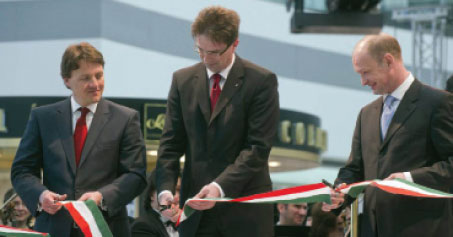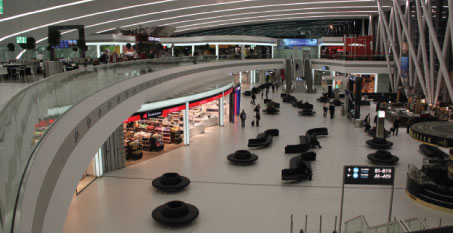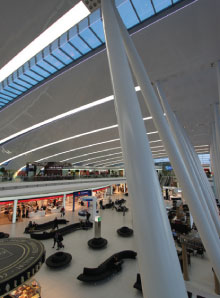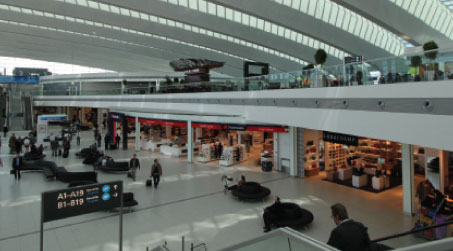
Reiner Schränkler, Chairman of the Board of Directors of Budapest Airport; Pál Völner, Hungary’s Secretary of State at the Ministry of National Development; and Jost Lammers, CEO, Budapest Airport, officially opened SkyCourt on 18 March.
Budapest Airport is a public-private partnership between the Hungarian State, which holds 25%, with HOCHTIEF AirPort owning the remaining 75%. The airport has two terminals; Terminal 1 is dedicated to low-cost carriers, with Terminal 2 used by the full-service carriers. It is also the base for national carrier Malév. Throughput reached 8.2 million in 2010 – up +1.2% year-on-year, and figures for Q1 2011 are positive with +8% growth year-on-year.
The full-service sector showed the strongest performance, with an increase of almost +20% in Q1. The low-cost segment was up by more than +6% and cargo traffic by around +5%. That success looks set to continue, with a record number of slots requested for the summer season. New routes already launched this year include Qatar Airways to Doha, American Airlines to New York, Jet2.com to Edinburgh, and airBaltic to Riga.
Malév currently has a 43.3% market share at Budapest and over the course of 2011 will increase its seat capacity on routes from the airport by +30.2%. The low-cost carriers operating at Budapest – Wizz Air, easyJet, Germanwings, jet2.com and Norwegian – account for a total market share of 22.2%; Wizz Air is the dominant LCC, with a 12.7% share of traffic.

Lammers: “The elegant, high-quality SkyCourt provides an unforgettable architectural and travel experience, as well as a rich selection of shops and restaurants. The new terminal makes travelling through the airport simpler and more convenient, as well as expanding throughput.”
‘Leap in quality’
SkyCourt is the key element of the BUD Future project, the aim of which is to develop Budapest Airport into the leading aviation hub in Central-Eastern Europe. The airport is investing €261 million in its development programme to end-2011 to achieve this aim, with the SkyCourt project accounting for 1102 million of that investment.
Traffic at Terminal 2 increases significantly during the summer season – to more than 30,000 passengers per day. The 12 new security lanes in the SkyCourt streamline the security process and enable a higher throughput, meaning a faster, more comfortable passage into the transit area for passengers. SkyCourt increases the airport’s capacity to 15 million passengers per year.
However, SkyCourt was not constructed solely to expand capacity, but also to enable a higher quality of service for passengers.

SkyCourt is the key element of the BUD Future project, the aim of which is to develop Budapest Airport into the leading aviation hub in Central-Eastern Europe.
“The elegant, high-quality SkyCourt provides an unforgettable architectural and travel experience, as well as a rich selection of shops and restaurants. The new terminal makes travelling through the airport simpler and more convenient, as well as expanding throughput,” explained Lammers.
Passengers on Malév flight MA 612 to London-Gatwick on 27 March were the first to enter the new central hall. “It was one of the duty managers who best summed up the experiences of the first few days when he said: “…everything is working as if the SkyCourt had been operating for years.” Passengers have been moving through the terminal with ease and self-confidence, which is a tribute to the coordinated work of the terminal’s designers and the team of engineers and facility management specialists who determined the layout of the inner spaces and supervised preparations for the opening,” commented Lammers. “Generally speaking, Budapest Airport has received positive feedback from a wide range of stakeholders and partners about SkyCourt. Virtually no negative feedback has been received so far. The quality of the building is confirmed by the fact that it received the prestigious Tierney Clark award for architectural excellence, even before it was opened. With the leasing of the commercial outlets in the SkyCourt, Budapest Airport effectively doubled the size of its commercial areas, thereby moving closer to the business model common for European airports in the 21st century of increased reliance on non-aeronautical revenues.”
BUD Future programme
The expanded commercial area has a wide range of retail outlets, including several international brands, and improved F&B. The 4,300sqm area features 39 new retail and F&B outlets, including a 1,400sqm walkthrough duty free store operated by Heinemann.
Lammers said: “We have had a proven, reliable partner here at the airport in Heinemann Duty Free for more than a decade. With the opening of SkyCourt, I am sure we will offer a premium category travel experience to passengers and shopping is an integral part of this. Heinemann’s offer will meet the taste of the most demanding passenger, whether it be cosmetics, liquor and wine, toys, Hungarian or international brands. Together we serve one common goal: to make air travel a truly joyful event for everybody.”

Lammers: “With the leasing of the commercial outlets in the SkyCourt, Budapest Airport effectively doubled the size of its commercial areas, thereby moving closer to the business model common for European airports in the 21st century of increased reliance on non-aeronautical revenues.”
Meanwhile, the building’s basement houses a state-of-the-art, computer-controlled, automatic baggage sorting system, which includes five baggage belts.
While SkyCourt is undoubtedly the central element of the BUD Future development programme, it is by no means the only element. Indeed, the development of Terminal 2 does not stop with the handover of SkyCourt. The airport has begun the complete internal refurbishment of Terminals 2A and 2B in phases, which are expected to be complete this autumn. The Cargo City development near Terminal 2 also began this year, with 26,000sqm of cargo storage areas and a logistics park to be built in the first phase. “Also in 2011, Budapest Airport commenced the planning and construction of a new engine test stand near the Lufthansa Technik hangar,” explained Lammers. “Less spectacular, but equally important elements of the BUD Future programme were the construction of apron northwest and the refurbishment of the Terminal 2 kerbside, both of which have already been completed.”
These developments, alongside expansion of the route network, make 2011 a historic year for the airport as it continues its strategy to become the leading aviation hub in Central-Eastern Europe.







